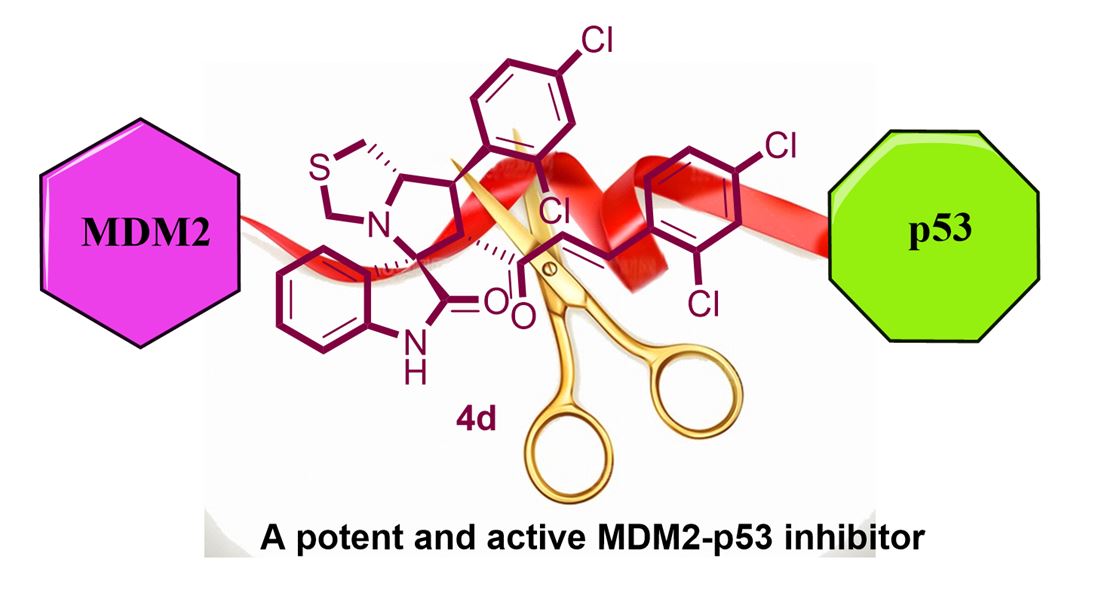Video Article Open Access
Spirooxindole Scaffold as a Potential Inhibitor for p53-MDM2 Interaction
Assem Barakat1,2,*, Mohammad Shahidul Islam1, Hussien Mansur Ghawas1, Abdullah Mohammed Al-Majid 1, Fardous F. El-Senduny3, Farid A. Badria4, Yaseen A. M. M. Elshaier5, and Hazem A. Ghabbour 6
1Department of Chemistry, College of Science, King Saud University, P. O. Box 2455, Riyadh 11451, Saudi Arabia
2Department of Chemistry, Faculty of Science, Alexandria University, P.O. Box 426, Ibrahimia, Alexandria 21321, Egypt
3Department of Chemistry, Faculty of Science, Mansura University, Mansura, Egypt
4Department of Pharmacognosy, Faculty of Pharmacy, Mansoura University, Mansoura 35516 Egypt
5Department of Organic and Medicinal chemistry, Faculty of Pharmacy, University of Sadat City, Menoufiya, Egypt
6Department of Medicinal Chemistry, Faculty of Pharmacy, University of Mansoura, Mansoura 35516, Egypt
Vid. Proc. Adv. Mater., Volume 2, Article ID 2021-0194 (2021)
DOI: 10.5185/vpoam.2021.0194
Publication Date (Web): 20 Mar 2021
Copyright © IAAM
Graphical Abstract

Abstract
The tumor suppressor p53 protein plays an important role in the cell by preventing the division of cells carrying mutated version of genome. Our approach is to synthesize a small molecule which will be able to block the MDM2–p53 interaction and regeneration of the p53.The designed compounds 4a-p were synthesized, in a simple smooth method using an asymmetric 1,3-dipolar reaction as the key step. The chemical structure for all synthesized compounds was elucidated and confirmed by spectral analysis. The molecular complexity and the absolute stereochemistry of 4b and 4e designed analogues was determined by X-ray crystallographic analysis. The cytotoxicity of the synthesized compounds was tested against colon (HCT-116), prostate (PC-3) and hepatocellular (HepG-2) cancer cell lines. Molecular modeling revealed that compound 4d binds through hydrophobic-hydrophobic interaction with the essential amino acids (LEU: 57:A, GLY: 58:A, ILE: 61:A, and His: 96:A) in the p53-binding cleft, as the standard p53-MDM2 inhibitor (6SJ). The mechanism of the anticancer activity of compound 4d was further evaluated and the study showed that compound 4d inhibited the colony formation, cell migration, arrested the cancer cell growth at G2/M and induced apoptosis through intrinsic and extrinsic pathway. The transactivation of p53 was confirmed where compound 4d increased the level of activated p53 by flowcytometry and induced mRNA level of cell cycle inhibitor p21.
Keywords
Spirooxindole; Anti-cancer; MDM2–p53 inhibitor.
Acknowledgement
We would like to thank King Saud University for supporting this research.
References
- Barakat et al., Bioorganic Chemistry, 2019, 86, 598-608; U.S. Patent 9,822,128, issued November 21, 2017.
Biography
Assem Barakat was born in Egypt in 1981. (B.Sc. Chemistry in 2002, Alexandria University, Egypt; Ph. D. in 2010 from Politecnico di Milano, Milano, Italy in a joint program with ETH, Zurich, Switzerland and University of Stuttgart, Germany). I joined King Saud University in 2011 as assistant Professor, then promoted into associate professor in 2017. Research interest focus on the organic synthesis of biologically active compounds. I have been accomplished more than 160 articles and 3 patents. Supervised 6 Master and 3 PhD students up to now.
Video Proceedings of Advanced Materials

Upcoming Congress



